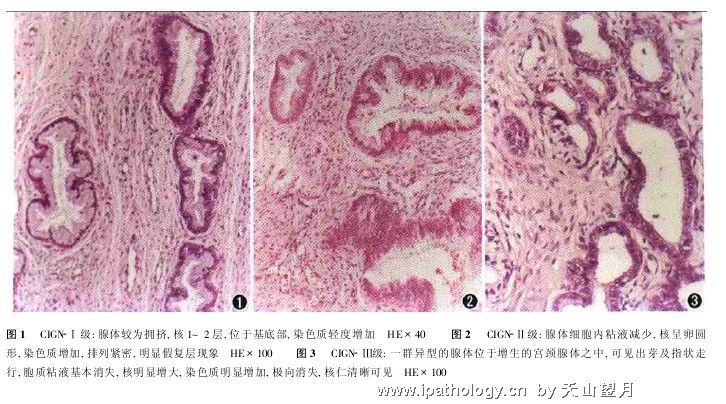| 图片: | |
|---|---|
| 名称: | |
| 描述: | |
- 请教专家:关于宫颈腺上皮瘤样病变和原位腺癌
-
本帖最后由 于 2009-02-01 23:24:00 编辑
结果专家说了算。不过专家不一定就对。
我觉得最关键的是临床的处理,了解了临床的处理就不用担心怎么诊断,说它是原位癌你就说细胞异型性你觉得够了,说它是非典你就说细胞不够癌的异型,形态学上我的感觉不管你说是什么其实都没人有充分的证据反驳你。就像月经周期还有个间期虽然排卵了但组织形态并没表现出来,我想非典到原位癌间也会有个“间期”的。
个人瞎想:可重复性太差。呵呵可能以后WHO会用什么方法把两者合并的。

- 蚕不知道自己会变成蛹,蛹不知道自己会变成蝶,当我们化羽成蝶的时候,就会发现那段变化的岁月是多么珍贵。
-
本帖最后由 于 2009-02-05 10:47:00 编辑
Here all people are same, pathologists.
There are some papers about GIGN. But this terminology never get widely accepted, even in the WHO classification. I assume that most gynecologic pathologists or pathologists do not use the term. AIS and glandular dysplasia are mentioned in WHO book. Glandular dysplasia is neoplastic lesion but it is not enough for AIS. Another term is glandular atypia. Glandular atypia mostly means bening reactive lesions.
In fact we almost never use term of glandular dysplasia in clinical practice. I think it is relatively easy to diagnose cervical glandular lesions. We use three terms: AIS, glandular atypia, glandular reactive change (atypia). We call glandular reactive atypia when we feel confident that it is a benign lesion. When I feel the lesion is not enough for AIS, and also I am not sure it is a benign reactive change, I may call glandular atypia, such as pseudostratification, rare mitoses. In clinical practice I seldom use the term glandular atypia, few times/per year. Most lesions can be easily to diagnose AIS or benign reactive changes. We never use GIGN. In pathology there are many bordline issues. It does not mean that experts always are right. We, as pathologists should let gynecologists or clinical physicians know the meaning of terms you used. Often we need to make a phone call with them.
Just for you reference.
Agree with Dr. Zhao!
In cervical biopsies and LEEPs, we mostly use AIS when it is diagnostic, rarely resort to glandular atypia, not sure it is benign or dysplasia or early AIS. When we use glandular atypia in report, we tell clinicians clearly they should follow up the patients with pap smears. Before we report glandular atypia, we always try to cut deeper, correlate with PAP or show to colleagues. Mostly we will be able to divide them into either benign or malignant. We never use glandular dysplasia. I think some books talk about it and it is probably more popular in europe. During my training, my attendings always tell me: it is either AIS or nothing, unlike squamous lesion, nothing in between. When it is reactive atypia or tubal metaplasia, i don't mention it in the report.
It is different in pap smears though. We do have atypical endocervical cells as a interpretation category, but no glandular dysplasia either. We report either AEC (atypical endocervical cells) or AIS.
Occasionally we see invasive adenocarcinoma of cervix too.
-
本帖最后由 于 2009-02-05 21:09:00 编辑
学习了楼上各位的观点,赞同!
我们在实际工作中,活检标本报原位腺癌时,一般在备注里加上不排除浸润之类,建议临床进一步检查。
然后临床一般做宫颈锥切,以进一步诊断。如果没有浸润,且切缘阴性,继续随访。如果有浸润,或者切缘阳性,扩大手术或切除子宫。然后进一步诊断和治疗,与浸润性宫颈腺癌相同,一般切除子宫+双附件并清扫盆腔淋巴结,年轻患者也可保留单侧卵巢+放疗(我不知道是否需要化疗)。
不足以诊断AIS的腺体改变,不区分dysplasia或atypia,模糊地称为非典型性腺体改变,建议随访。
明确的良性反应性改变,忽略不报。
如Zhao所述,我们用p16和Ki67协助诊断AIS。另外,来自宫颈腺病变与内膜腺病变的区分有时非常困难,需要临床提供详细资料,有时加做CEA,ER,Vim会有帮助。
不知当否?欢迎大家提供自己的经验。

华夏病理/粉蓝医疗
为基层医院病理科提供全面解决方案,
努力让人人享有便捷准确可靠的病理诊断服务。
| 以下是引用abin在2009-2-5 21:06:00的发言:
学习了楼上各位的观点,赞同! 我们在实际工作中,活检标本报原位腺癌时,一般在备注里加上不排除浸润之类,建议临床进一步检查。 然后临床一般做宫颈锥切,以进一步诊断。如果没有浸润,且切缘阴性,继续随访。如果有浸润,或者切缘阳性,扩大手术或切除子宫。然后进一步诊断和治疗,与浸润性宫颈腺癌相同,一般切除子宫+双附件并清扫盆腔淋巴结,年轻患者也可保留单侧卵巢+放疗(我不知道是否需要化疗)。 不足以诊断AIS的腺体改变,不区分dysplasia或atypia,模糊地称为非典型性腺体改变,建议随访。 明确的良性反应性改变,忽略不报。 如Zhao所述,我们用p16和Ki67协助诊断AIS。另外,来自宫颈腺病变与内膜腺病变的区分有时非常困难,需要临床提供详细资料,有时加做CEA,ER,Vim会有帮助。 不知当否?欢迎大家提供自己的经验。 |
























